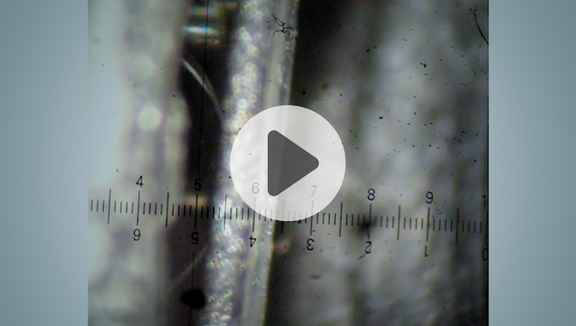
Making the assumption that the pressure ratios in the human body can be described using hydrostatics alone allows us to reach a basic understanding of these phenomena. This alone is sufficient to allow us to observe and measure them. This can be very important when treating hydrocephalus, e.g. when avoiding overdrainage.
However, it still constitutes a gross simplification of the actual, highly complex conditions within the human body. Finally, the CSF in the brain is produced by the blood and resorbed by it. As a result, there are sources and sinks, and therefore, flow, even if it is slow. The CSF circulates around the cerebral ventricular system as a result of the pulsing of the arteries within the cerebral ventricle and, according to the latest research, due to the significant effect of the movements the body makes when breathing. Modern flow-sensitive real-time MRI scans of the human skull actually provide convincing proof that this circulation takes place (Dreha-Kulaczewski1, 2017).
Hydrodynamics in the shunt
The flow manifests itself if cerebral ventricular system is "disturbed" by a shunt: the difference in pressure between the ventricles and the peritoneum allows for a "net flow" of CSF into the peritoneum through the artificial channel, which is regulated by a special differential pressure or hydrostatic valve. According to the continuity equation, when liquid is being continuously produced, it flows more quickly the narrower the channel is. Because of this, the liquid will flow more quickly through a relatively narrow catheter than, for example, a reservoir with a significantly larger flow cross-section. If, for example, 20 ml of CSF is drained per hour, it will flow through the catheter at a constant rate of 5 millimetres per second. However, the speed of the liquid increases in direct proportion to the cross section width what it is flowing through.
The continuity equation
The continuity equation is one of the basic equations of hydrodynamics and can be interpreted as a simple mass equation at a control volume. To put it more simply: “What goes in must come out”. This can be worked out in quite a clear way and with only a little basic knowledge of physics and mathematics by using the following axioms:
- (Mass/time)_in = (mass/time)_out
- Mass=density*volume / / Assumption: the density is constant.
1. means that in 2: (Volume/time)_in = (volume/time)_out
<-> ((Time) * (distance/time))_in = ((area) * (distance/time)_out / / Speed = distance/time with volume = area * distance
Therefore:
V_in*A_in = V_out*A_out

Some may know it from canoeing through narrow canals: The narrower the canal, the faster the canoe floats with the current.
Some of you might already be familiar with this effect from canoeing down narrow channels: the narrower the channel is, the faster the canoe floats along with the current.
If then the flow rate through a hydrocephalus valve with a potentially enlarged cross section is slowed down, the tissue particles, proteins and sometimes also blood may interact with and adhere to the interior surfaces of the valve due to long periods of exposure (due, in part to turbulence and bottlenecks at places with an irregular geometry, where the CSF is almost still). This can gradually lead to valve occlusion.
"... found in relation to toxicity and oncogenity. Minor problems existed in relation to CSF proteins and medium difficulties in relation to corpuscles (blood). Surprisingly with 500 mg/dl protein, most valves showed – in short term – no significant alteration except of some sticking proximal slit probes and sometimes Orbis-Sigma valves. The trials of Brydon et al. (1996) could be confirmed. Protein effects are usually overestimated. Corpuscles and blood are more by far at risk for valve occlusions (Aschoff 1995)."
Aschoff2, 2019
Understanding of the exact mechanisms of valve occlusions.at a molecular level is important for the long-term success of a shunt, and is therefore currently the subject of scientific research. We still do not know very much at all about the reasons why blockages occur. However, we suspect that taking flow speed into account is probably of greater importance when designing shunt systems.
Noises in the valves
The flow rate through the pump can also be important for reasons other than occlusions. The occurrence of valve noises (which have been reported by some hydrocephalus patients) can also be explained by phenomena related to the flow rate of the CSF.
This can be illustrated with a simple differential pressure valve. For example, with a ball-cone valve, the pressure proximal to the shunt builds up until it can overcome the force of the spring element in the valve. When the force generated by the pressure finally exceeds the spring force, the ball moves, opening the liquid channel, which means the fluid can move.
Specific conditions may cause the valve to close right after opening, due to a sudden pressure drop in the CSF. One of the reasons for this pressure drop is the reduction in pressure on the side subject to overpressure, due to the liquid being drained away. This can take place very quickly, depending on the specific anatomy of the person (e.g. cerebral compliance, split ventricles etc.). There is also another type of pressure drop, which can be explained by what is known as "Bernoulli's equation". This states that the pressure in a moving fluid is lower than that in a fluid that is still. What this actually means for the valve is that the faster CSF moves through the open valve, the bigger the pressure drop that follows and, in turn, the greater the likelihood of the valve closing quickly again will be.
Bernoulli's equation
For those with an interest in fluid mechanics, Bernoulli's equation is something that often provides an initial insight into the conditions within otherwise complex hydraulic systems. Ultimately, it is a variation of the principle of conservation of energy, which states that the sum of potential energy density (the hydrostatic column of water), kinetic energy density and the energy of the forces within the fluid (static pressure) always remains constant along a streamline:
Special definition Potential energy + special definition Kinetic energy + special definition Internal energy = const.
rho g h + ½ rho v² + p = const.
Strictly speaking, this only applies to homogenous flows. These are idealised, i.e. hypothetical flows that are stationary (no local variations in velocity), incompressible and free of pressure loss. There are, however, formulations of Bernoulli's equation that take pressure loss caused by turbulence or pipe friction into account by adding another term.
An outcome of this equation is that the internal or "static" pressure of a liquid becomes lower the more quickly the fluid moves. This is often clearly demonstrated by using the example of the so-called Venturi tube, which is shown in the following diagram:

Although the flow velocity is highest at the narrowest cross section (cf. the continuity equation), this is also where the internal pressure of the flow is at its lowest, causing the column of liquid in the U-tube manometer in the diagram to shift in the way depicted.
To allow the pressure to immediately start building up again, it is therefore necessary to repeatedly open and close the valve, which also creates audible noises.

This phenomenon can also be proved experimentally, as can be see in the following video:
We can therefore see the following: Although fundamental phenomena of cerebrospinal pressure and hydrocephalus therapy can be described using simple hydrostatic models, you cannot avoid also using hydrodynamic models when seeking to understand fluid mechanics and their effects within the shunt.
This does not come close to answering all the questions there are regarding hydrostatics and hydrodynamics in shunt systems. I look forward to receiving suggestions or questions that we can address in greater detail in other articles.
Finally, and to further emphasise this complexity, the "simple" physical answer to a question we are often asked. That is, why the opening pressures of a series of closed valves have to be added up:
1 + 1 = 1? Or Adding up the opening pressures of a series of closed valves
The balanced equations of fluid mechanics can also help to explain a popular misconception in relation to the combination of hydrocephalus valves and, in particular the series connection of valves with different opening pressures. Are the individual opening pressures really added up? Doesn't the higher opening pressure control the flow of CSF through the shunt, as the more dominant one of the two?
By having regard to hydrodynamic balancing equations and a bit of faith in theoretical physics, this question can be answered without having to conduct any experiments. This only requires a simple momentum balance, or, in a borderline hydrostatic case, a power balance as well, with the control volume being provided by "the column of CSF in the shunt". Taking into account the fact that the column of liquid being observed constitutes a so-called continuum and every mass within the liquid creates pressure on the border of the control volume makes it clear that the individual masses are not entered into the balance equation separately, rather, they are inserted into it after having been added up.
Or to explain things in more detail, as well as in simpler and less abstract terms:
Let us imagine a series of two simple ball-cone valves with two different (blue) springs, one behind the other.

The blue springs have different spring constants - one has a low spring constant (SC1) and the other has a high spring constant (SC2). The liquid medium in between is incompressible and can therefore (thankfully) be replaced, e.g. by a steel rod (depicted in green), which connects them both to each other and therefore transfers the force directly. It now becomes clear that the entire system can only be opened when the steel rod is pressed down with a force that counteracts the sum of BOTH SPRING CONSTANTS, SC1 + SC2, which is what is meant by a balance of forces.
Bibliography
Dreha-Kulaczewski 2017: Inspiration is the major regulator of human CSF flow
Aschoff 2019: in In-Depth View — Functional Characteristics of CSF Shunt Devices (Pros and Cons)
Kästner 2017: I can hear my shunt — audible noises associated with CSF shunts in hydrocephalic patients
